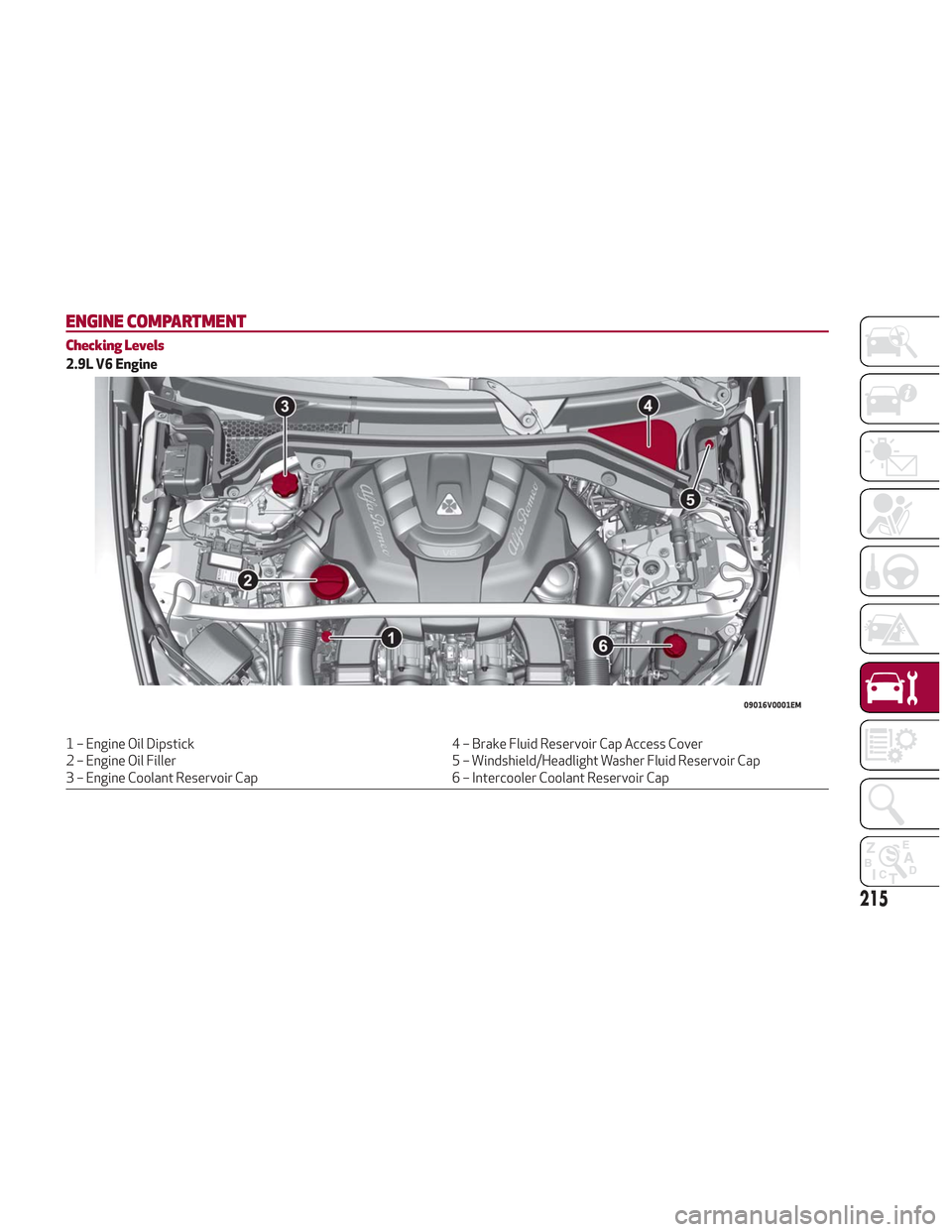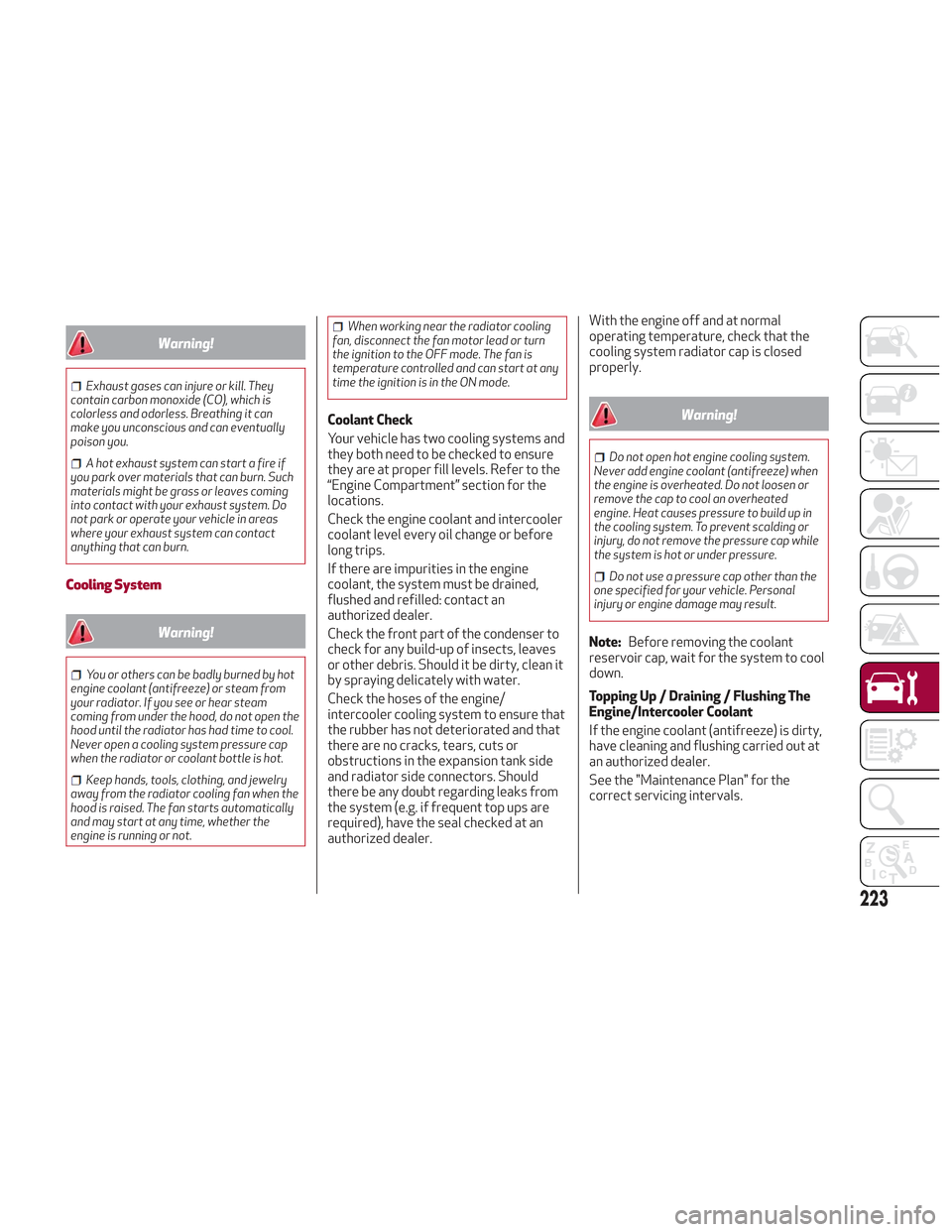2018 Alfa Romeo Stelvio coolant reservoir
[x] Cancel search: coolant reservoirPage 89 of 276

Caution!
If the LOW ENGINE OIL PRESSURE symbol switches on when driving, stop the engine immediately and contact an authorized dealer.
Warning LightWhat It Means What To Do
ENGINE TEMPERATURE WARNING LIGHT
This telltale warns of an overheated engine condition. If
the engine coolant temperature is too high, this indicator
will illuminate and a single chime will sound. If the
temperature reaches the upper limit, a continuous chime
will be sound for four minutes or until the engine is
allowed to cool whichever comes first.In normal driving conditions
: stop the vehicle, shut off the
engine and check that the coolant level in the reservoir is
not below the MIN mark. In this case, wait for the engine
to cool down, then slowly and carefully open the cap, top
offwith coolant and check that the level is between the
MIN and MAX marks on the reservoir itself. Also check
visually for any fluid leaks. Contact an authorized dealer if
the telltale comes on when the engine is started again.
If the vehicle is used under demanding conditions (e.g. in
high-performance driving): slow down and, if the telltale
stays on, stop the vehicle. Stop for two or three minutes
with the engine running and slightly accelerated to
facilitate better coolant circulation, then turn the engine
off. Check that the coolant level is correct as described
above.
87
Page 217 of 276

ENGINE COMPARTMENT
Checking Levels
2.9L V6 Engine
1 – Engine Oil Dipstick4 – Brake Fluid Reservoir Cap Access Cover
2 – Engine Oil Filler 5 – Windshield/Headlight Washer Fluid Reservoir Cap
3 – Engine Coolant Reservoir Cap 6 – Intercooler Coolant Reservoir Cap
09016V0001EM
215
Page 218 of 276

Engine Oil
The engine oil level can be seen on the
instrument cluster display every time the
engine is started, or on the Information
and Entertainment system display by
activating on the main menu (MENU
button) the following functions in
sequence:
1. “Apps”
2. “My Car”
3. “Oil Level”
Check on the display using the 6 notches
that the oil level is between the MIN and
MAX level: 1 notch MIN level, 6 notches
MAX level.
If the oil level is close to or below the MIN
mark, add oil gradually through the filler,
(refer to “Top-Up And Oil Level Indication
Update On Display” in this section)
considering that each notch shown on the
display corresponds to approximately
8.8floz(250ml).
Caution!
Make sure not to add too much oil when
topping off the engine. Engine oil in excess
may damage the engine. Have the vehicle
checked. Never exceed the MAX level when
topping off engine oil.
Caution!
The oil level is not refreshed immediately on
the display after topping off. Consequently,
wait for the oil level to be refreshed on the
display and follow the procedure below.
Note:Always reinstall the oil cap and
tighten to proper torque whenever it is
removed to add oil to engine. Never run
the engine with cap removed this could
cause oil to leak from engine.
Top-Up And Oil Level Indication Update
On Display
If a engine oil top-off is needed, in order
to ensure the correct indication of the oil
level on the display, leave the vehicle on
flat ground with the engine running for
approximately five minutes (temperature
higher than 176°F (80°C)) and shut the
engine off. Then, start the engine again,
and idle it for about five minutes.
Note: If you have added the specified
amount of oil and the indicator is not
reading “Full”, please contact an
authorized dealer.
Warning!
If the engine oil is being topped up, wait for
the engine to cool down before loosening the
filler cap, particularly for vehicles with
aluminium cap (if equipped). WARNING: risk
of burns!
Caution!
The oil level must never exceed the MAX
mark.
If the MAX mark is exceeded MAX (last
notch on the right turns red) after the fill-up,
go to an authorized dealer as soon as
possible to have the oil in excess removed.
Do not add oil with specifications
different from those of the oil already in the
engine.
Used engine oil and oil filters contain
substances which are harmful to the
environment. To change the oil and filters,
we advise you to contact an authorized
dealer.
Engine Coolant Fluid
If the level is too low, unscrew the cap of
the reservoir and add the fluid described
in the "Technical Specifications" chapter.
216
SERVICING AND MAINTENANCE
Page 225 of 276

Warning!
Exhaust gases can injure or kill. They
contain carbon monoxide (CO), which is
colorless and odorless. Breathing it can
make you unconscious and can eventually
poison you.
A hot exhaust system can start a fire if
you park over materials that can burn. Such
materials might be grass or leaves coming
into contact with your exhaust system. Do
not park or operate your vehicle in areas
where your exhaust system can contact
anything that can burn.
Cooling System
Warning!
You or others can be badly burned by hot
engine coolant (antifreeze) or steam from
your radiator. If you see or hear steam
coming from under the hood, do not open the
hood until the radiator has had time to cool.
Never open a cooling system pressure cap
when the radiator or coolant bottle is hot.
Keep hands, tools, clothing, and jewelry
away from the radiator cooling fan when the
hood is raised. The fan starts automatically
and may start at any time, whether the
engine is running or not.
When working near the radiator cooling
fan, disconnect the fan motor lead or turn
the ignition to the OFF mode. The fan is
temperature controlled and can start at any
time the ignition is in the ON mode.
Coolant Check
Your vehicle has two cooling systems and
they both need to be checked to ensure
they are at proper fill levels. Refer to the
“Engine Compartment” section for the
locations.
Check the engine coolant and intercooler
coolant level every oil change or before
long trips.
If there are impurities in the engine
coolant, the system must be drained,
flushed and refilled: contact an
authorized dealer.
Check the front part of the condenser to
check for any build-up of insects, leaves
or other debris. Should it be dirty, clean it
by spraying delicately with water.
Check the hoses of the engine/
intercooler cooling system to ensure that
the rubber has not deteriorated and that
there are no cracks, tears, cuts or
obstructions in the expansion tank side
and radiator side connectors. Should
there be any doubt regarding leaks from
the system (e.g. if frequent top ups are
required), have the seal checked at an
authorized dealer. With the engine off and at normal
operating temperature, check that the
cooling system radiator cap is closed
properly.Warning!
Do not open hot engine cooling system.
Never add engine coolant (antifreeze) when
the engine is overheated. Do not loosen or
remove the cap to cool an overheated
engine. Heat causes pressure to build up in
the cooling system. To prevent scalding or
injury, do not remove the pressure cap while
the system is hot or under pressure.
Do not use a pressure cap other than the
one specified for your vehicle. Personal
injury or engine damage may result.
Note: Before removing the coolant
reservoir cap, wait for the system to cool
down.
Topping Up / Draining / Flushing The
Engine/Intercooler Coolant
If the engine coolant (antifreeze) is dirty,
have cleaning and flushing carried out at
an authorized dealer.
See the "Maintenance Plan" for the
correct servicing intervals.
223
Page 226 of 276

Note:
For topping up, refer to "Fluids And
Lubricants" in "Technical Specifications"
for proper coolant specifications.
Do not use pure water, alcohol-based
coolants, corrosions inhibitors or
additional anti-rust products because
they may be incompatible with the
engine coolant and cause the clogging
of the radiator. The use of propylene
glycol-based coolant is also not
recommended.
Engine Cooling/Intercooler System Cap
To prevent loss of engine coolant, make
sure that the expansion tank cap is
closed. If it is open, screw it completely
until you reach/hear the click.
Periodically check the cap and clean it
from any foreign bodies that may have
deposited on the external surface.
Warning!
Never add coolant with the engine hot or
overheated.
Do not attempt to cool an overheated
engine by loosening or removing the cap. The
heat causes a considerable increase in
pressure in the cooling system.
To prevent damage to the engine, only
use the engine cooling circuit caps provided.
Disposal of Used Coolant
Disposal of engine/intercooler coolant is
subject to legal requirements. Contact
the appropriate body to determine local
regulations.
Note:
To prevent the fluid from being
ingested by children or animals, do not
keep it in open containers or pour it on
the ground. If ingested, contact a doctor
immediately. Eliminate any traces of
fluid from the ground immediately.
When the vehicle stops after a short
trip, steam may be seen coming out
from front of the hood. This is a normal
phenomenon which is due to the
presence of rain, snow or a lot of
moisture on the surface of the radiator.
With engine and system cold, do not
top up with coolant beyond the
maximum level indicated on the
reservoir in the engine compartment.
Braking System
In order to guarantee the efficiency of
the braking system, periodically check its
components; for this operation, contact
an authorized dealer.
See the "Maintenance Plan" for the
correct servicing intervals.
Note: Driving with your foot resting on
the brake pedal may compromise its
efficiency, increasing the risk of accidents. When driving, never keep your
foot on the brake pedal and don’t put
unnecessary strain on it to prevent the
brakes from overheating. Excess pad
wear may cause damage to the braking
system.
When an insufficient oil level is
detected, contact an authorized dealer
to have the system checked.
Always keep the cap of the brake
fluid reservoir (in the engine
compartment) completely closed.
Warning!
Use only manufacturer's recommended
brake fluid. Refer to “Fluids And Lubricants”
in “Technical Specifications” for further
information. Using the wrong type of brake
fluid can severely damage your brake
system and/or impair its performance. The
proper type of brake fluid for your vehicle is
also identified on the original factory
installed hydraulic master cylinder
reservoir.
To avoid contamination from foreign matter
or moisture, use only new brake fluid or fluid
that has been in a tightly closed container.
Keep the master cylinder reservoir cap secured
at all times. Brake fluid in a open container
absorbs moisture from the air resulting in a
lower boiling point. This may cause it to boil
unexpectedly during hard or prolonged braking,
resulting in sudden brake failure. This could
result in a collision.
224
SERVICING AND MAINTENANCE